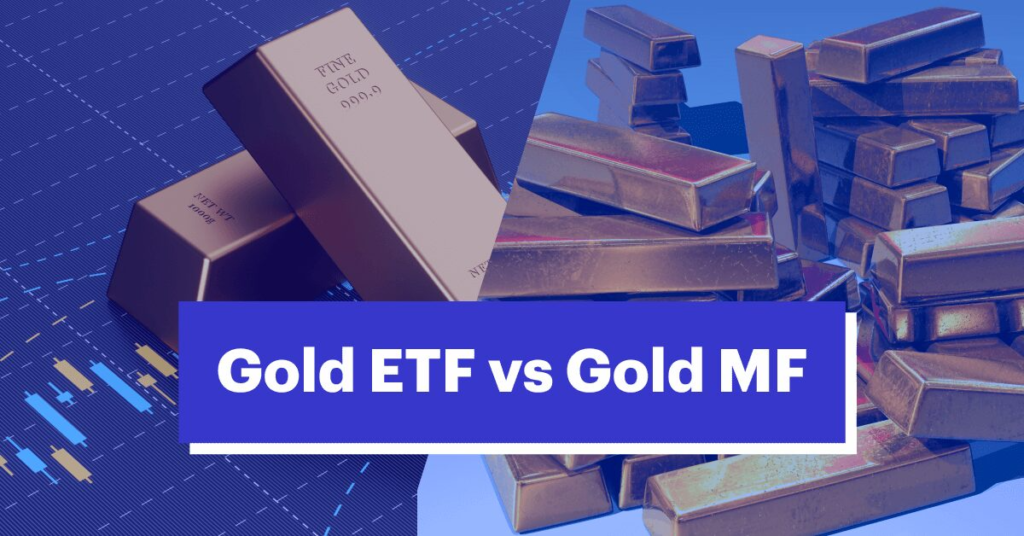Investors considering gold investments for their portfolios engage in serious discussions about these two financial products: Gold Exchange Traded Funds and Gold Mutual Funds. Both instruments give exposure to movements in the prices of gold without the need for holding that gold in physical form. That makes it an interesting comparison with regards to a Systematic Investment Plan (SIP). These instruments help SIP investors to grow their investments via a steady contribution of a fixed amount each month. With this understanding, let us analyze the comparison of gold ETF versus gold mutual fund and its implications in SIP of ₹5000 monthly in ten years.
Learning the Basics
Exchange-Traded Fund is a term for securities tracking an underlying index or an asset with market trading on it. Therefore, Gold ETFs will be so-called Exchange-Traded Funds that track prices of gold. The investor purchases units on the Exchange, with every unit representing a certain quantity of gold.
Conversely, Gold Mutual Funds are mutual fund schemes investing either in physical gold or Gold ETFs. Investing in them does not require a demat account or trading account on the part of investors. A professional fund manager pools the money of investors and gains exposure to gold.
From the perspective of the SIP investor, gold ETF versus gold mutual fund has a very different structure in terms of cost and accessibility, but one would have an impact on SIP investors relatively differently.
SIP in Gold ETFs
SIP in Gold ETFs cannot be direct. The investors are not allowed to set it up for an automatic monthly debit like in mutual funds. They must purchase units on their own once each month through their trading account. A few platforms may also allow systematic buying of ETFs. Yet this again requires an account linked to the exchange.
All-in-all, if an investor would put ₹5,000 every month for 10 years in the Gold ETF system, the returns will somewhat follow gold price movements with some adjustments financially, i.e., less some brokerage and transaction charges and coupon of fund expenses. Some other issue here relates to liquidity: Gold ETFs are listed and traded on exchanges, and their price is, during the market hours, a function of genuine demand and supply for the ETF.
SIP in Gold Mutual Funds
Gold Mutual Funds provide a much easier mechanism for SIPs. Investors can easily set up an automated debit that withdraws ₹5,000 every month without having the need to open a trading account. The debit funds the investment of the Gold Mutual Fund, which, in turn, invests in Gold ETFs or other related instruments.
For these means of returns to gold prices, the mutual fund will charge an expense ratio plus any fees of the Gold ETF. Under such dual-share structures, it may squeeze an extra cost compared to direct investing in an ETF; however, the very comfort of an automated SIP will attract those investors who want to keep it minimal in participation.
Comparative Analysis Of ₹5,000-For-10-Years
Pragmatic considerations make it a matter of fair comparison when looking at gold ETF versus gold mutual fund and the investment of ₹5,000 per month over ten years:
Accessibility:
For Gold ETFs, opening a trading and demat account is mandatory. SIPs can rarely get fully automated.
Gold Mutual Fund SIPs require simply setting up with a bank mandate.
Costs:
Gold ETF is related to administrative cost plus brokerage or transaction costs.
Gold Mutual Fund accounts offer their management fees plus those associated with the underlying ETF.
Liquidity:
Gold ETFs trade like stocks, letting Investors sell the units at any time during market hours.
Gold Mutual Funds will redeem on end-of-day Net Asset Value (NAV).
Returns:
For the 10-year period, both products aspire to reflect on gold price.
Returns depend on tracking errors, expense ratios, and transaction costs.
If an investor puts ₹5,000 a month in SIP for 10 years, that leads to a corpus of ₹6 lakhs, and the return on this corpus over 10 years is primarily dependent on the price of gold. The deviation between the two, Gold ETF and Gold Mutual Fund, perhaps will not be too much; rather, it can be said that expenses and convenience will have a good divergence on this formed effective corpus.
What Is Better for SIP Investors?
About Gold Mutual Funds, it does provide reasonable support to SIP habit for investors looking for added automation that makes for carefree ease-of-use. Setting a monthly debit seems to almost take up no time at all. Conversely, Gold ETFs are most likely apt for those trying to starkly minimize on expenses while being interactive with an open trading account.
The crux of the matter is that both institutions serve essentially the same purpose of providing gold in a financing format. This is the point where the investor goes for convenience as opposed to cost efficiency.
Conclusion
The returns for Gold ETF versus Gold Mutual Fund are similar; major distinguishing traits arise from structure, cost, and process. An Exchange Traded Fund which offers a unique alternate to direct market access. The Gold Mutual Fund offers easier SIPs.
For anyone investing at ₹5,000 for 10 years, both will give an alternate exposure to gold prices. However, they will differ fast. Gold ETF basically lets one go for the price of gold from the much more active participation and trading costs, while Gold Mutual Funds tend to lend a hand with a lot more straightforward and less burdensome process but are marginally higher on cost structure. Now that one understands the dynamics, an SIP investor can align either of the products according to their choice and investing style.
